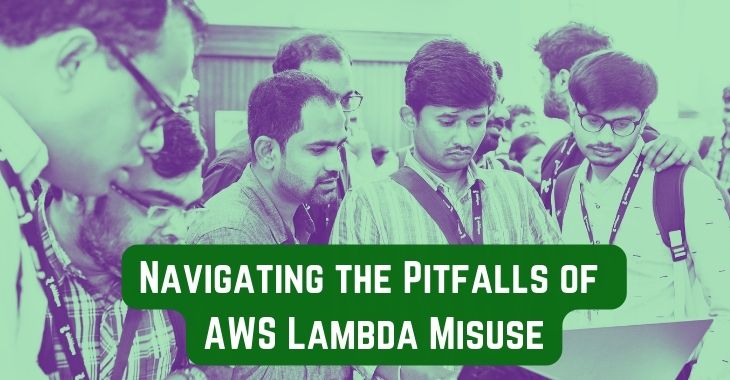
“Once again Saltmarch has knocked it out of the park with interesting speakers, engaging content and challenging ideas. No jetlag fog at all, which counts for how interesting the whole thing was."
Cybersecurity Lead, PwC

Serverless computing has emerged as a game-changer. AWS Lambda, in particular, has become the darling of developers, offering a serverless computing service that runs your code in response to events, automatically managing the underlying compute resources for you. However, as with any powerful tool, misuse can lead to unintended consequences. This article delves into the Lambda Pinball Antipattern, the misuse of tools and techniques, and when to rethink the serverless approach.
The Dark Side of Success: The Lambda Pinball Antipattern
The Lambda Pinball Antipattern is a term coined by ThoughtWorks to describe a situation where developers misuse serverless functions, leading to a complex, tangled web of interactions that is difficult to manage and debug. It's like a pinball machine, where the ball (or in this case, the data) bounces unpredictably from one function to another.
One real-world example of this can be found in the AWS Lambda documentation. A company used multiple Lambda functions to process data, but without proper orchestration, the functions became a chaotic mess, leading to increased latency and cost overruns. The company had to spend significant resources untangling the mess, which could have been avoided with a more thoughtful approach to using Lambda functions.
Chris Ford, a software engineer, shared a similar experience on Twitter. He described a project where the misuse of Lambda functions led to an architecture that was nearly impossible to untangle, causing significant delays in development. The project, which should have been a straightforward implementation, turned into a nightmare due to the misuse of serverless functions.
The Lambda Pinball Antipattern is a stark reminder of the risks and challenges that come with the misuse of serverless functions. While AWS Lambda functions offer many benefits, it's crucial to use them judiciously to avoid creating a system that's more akin to a pinball machine than a well-oiled machine.
Tools and Techniques: Friend or Foe?
In the world of serverless computing, there are many tools that facilitate sharing code between Lambdas or orchestrate complex interactions. However, these tools can be a double-edged sword. When used without a proper understanding of their implications, they can lead to the recreation of architecture antipatterns.
The AWS Compute Blog highlights a case where a company used AWS Step Functions to orchestrate Lambda functions. While AWS Step Functions is a powerful tool that provides state machines to coordinate the components of distributed applications and microservices, the company didn't consider the potential for increased complexity. They ended up with a system that was difficult to manage and scale, leading to performance issues and increased costs.
The Simform Blog echoes this sentiment, cautioning against the misuse of tools like AWS SAM and Serverless Framework. These tools, while powerful, can lead to the creation of tightly coupled systems if not used correctly. Tightly coupled systems can hinder scalability and maintainability, leading to long-term issues that can be difficult to resolve.
These examples underscore the importance of understanding the tools and techniques at your disposal. While these tools can be incredibly beneficial, misuse can lead to the creation of systems that are more complex and difficult to manage than necessary.
Rethinking the Approach: When to Use Serverless
Serverless is not a one-size-fits-all solution. It's crucial to understand the trade-offs and to know when it's time to rethink the suitability of the approach.
The AWS Compute Blog advises considering factors such as the complexity of the system, the need for long-running processes, and the cost implications before deciding to go serverless. It warns against using Lambda functions for tasks that require long execution times, as this can lead to increased costs and potential timeouts. For instance, tasks that require more than 15 minutes to execute may not be suitable for Lambda functions, as they have a maximum execution time of 15 minutes.
The Simform Blog also provides valuable insights, suggesting that serverless may not be the best choice for applications that require complex transactional operations or have strict latency requirements. It emphasizes the importance of understanding the limitations of serverless before diving in. For example, serverless may not be the best choice for applications that require a persistent connection to a database, as this can lead to connection pooling issues.
Navigating the Future of Serverless Computing
In the labyrinth of AWS Lambda functions and serverless computing, understanding the potential pitfalls is as crucial as appreciating the benefits. The Lambda Pinball Antipattern, the misuse of tools and techniques, and the need to rethink the serverless approach are all critical considerations for developers and tech leads. As we've explored in this article, judicious use of these powerful tools and a deep understanding of their implications can help navigate this labyrinth successfully.
Have questions or comments about this article? Reach out to us here.
Banner Image Credits: Attendees at Great International Developer Summit

“Once again Saltmarch has knocked it out of the park with interesting speakers, engaging content and challenging ideas. No jetlag fog at all, which counts for how interesting the whole thing was."
Cybersecurity Lead, PwC

“Very much looking forward to next year. I will be keeping my eye out for the date so I can make sure I lock it in my calendar."
Software Engineering Specialist, Intuit

“Best conference I have ever been to with lots of insights and information on next generation technologies and those that are the need of the hour."
Software Architect, GroupOn

“Happy to meet everyone who came from near and far. Glad to know you've discovered some great lessons here, and glad you joined us for all the discoveries great and small."
Web Architect & Principal Engineer, Scott Davis

“Wonderful set of conferences, well organized, fantastic speakers, and an amazingly interactive set of audience. Thanks for having me at the events!"
Founder of Agile Developer Inc., Dr. Venkat Subramaniam

“What a buzz! The events have been instrumental in bringing the whole software community together. There has been something for everyone from developers to architects to business to vendors. Thanks everyone!"
Voltaire Yap, Global Events Manager, Oracle Corp.